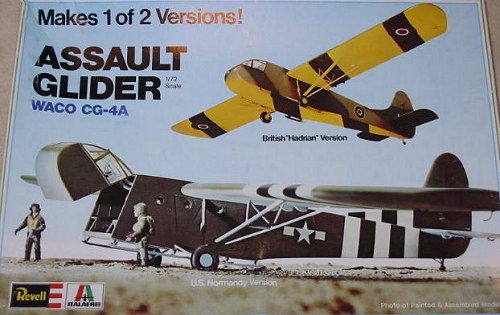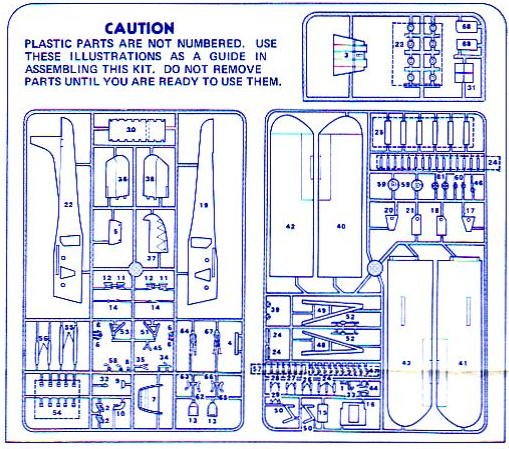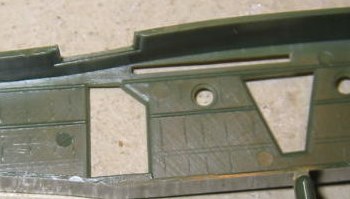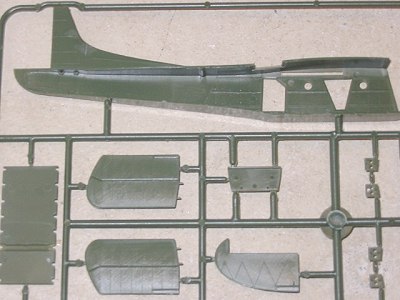
|
KIT: |
Revell 1/72 Waco CG-4A Glider |
|
KIT # |
H-2012 |
|
PRICE: |
$5 when new but it is long OOP |
|
DECALS: |
Three aircraft |
|
REVIEWER: |
Bill Michaels |
|
NOTES: |
Kit is reboxed Italeri mold. |

|
HISTORY |
The successful German airborne invasion of Crete in 1941 made a big impression on the Allies, who set out to develop their own parachute and glider troops. The US Army selected the Waco CG-4A to be its standard glider, and the first model flew in 1942.
The CG-4A was built with steel tubing and wood, and covered with fabric. It could carry 15 fully equipped troops, or a jeep, or a 75mm howitzer and its crew. The nose of the glider could be swung up for loading and unloading. There were also doors in the sides of the fuselage. An interesting fact is that when carrying a jeep or other large item, a sturdy cable connected the cargo to the hinged nose. If the cargo shifted on landing, the cable would pull the nose (and the pilots) up and out of the way so the cargo didn’t crush them.
The C-46 and C-47 transports were used as tugs, and a single aircraft could tow aloft two or three gliders. When in flight, the towline could be dropped by either the glider or transport pilot. An intercom cable was part of the towline, so the pilots could converse in flight.
The CG-4A was first used in the invasion of Sicily. Results were mixed, hampered in part by bad weather and pilot error. Navigational errors and a strong headwind caused some the gliders to be released too soon, and they landed in the sea. The gliders that were released near their targets were fairly successful, though.
The CG-4A was used in the Normandy invasion, the Arnhem operation, and in the crossing of the Rhine. The glider was also used successfully in Burma, landing troops and supplies for Merrill’s Marauders behind Japanese lines. The glider was the standard US Army glider, but it was also used by the British. The British called the glider the “Hadrian”, and used it in conjunction with their own “Hotspur” glider.
The glider had skids on the bottom of the fuselage, and removable main wheels as well. The wheels were used for takeoffs, and training landings. It was originally intended to land on the skids in combat, but that idea was dropped when it was found that the glider was more controllable on landing with the wheels.
|
THE KIT |
 I believe this kit was originally an Italieri kit. (And
Bill is quite correct. Revell reboxed quite a large number of Italeri kits
during this time. Now Revell of Germany continues this trend by not only
reboxing Italeri kits, but also Hasegawa and Matchbox ones. BTW, the extra "i"
in Italieri was dropped in the late 1980s. Ed) I
bought my first copy in 1984, in a Testors/Italieri box. The copy I’m
previewing here is a Revell boxing, though both the Revell and Italieri logos
are on the instructions.
I believe this kit was originally an Italieri kit. (And
Bill is quite correct. Revell reboxed quite a large number of Italeri kits
during this time. Now Revell of Germany continues this trend by not only
reboxing Italeri kits, but also Hasegawa and Matchbox ones. BTW, the extra "i"
in Italieri was dropped in the late 1980s. Ed) I
bought my first copy in 1984, in a Testors/Italieri box. The copy I’m
previewing here is a Revell boxing, though both the Revell and Italieri logos
are on the instructions.
The kit consists of 68 parts, molded in dark green, with clear parts for the windows. The surfaces have a very fine fabric detail, with fine raised lines representing some of the stitching. My kit was well molded, with the only flash on the trailing edge of the stab. The kit includes two standing figures—one pilot and one paratrooper. (Glider infantry didn’t wear parachutes- this guy belongs next to a C-47.)
Markings for three versions are included:
 The cockpit starts with two nicely shaped seats, with
separate mounting brackets. Also provided are a console, instrument panel,
and individual rudder pedals. The troop compartment includes a cargo floor
and troop seats. The doors are all molded separately, and the nose section is
moveable. The fuselage has some fabric and structure detail on the inside of
the troop compartment. Italieri clearly had the diorama builder in mind when
they did this kit!
The cockpit starts with two nicely shaped seats, with
separate mounting brackets. Also provided are a console, instrument panel,
and individual rudder pedals. The troop compartment includes a cargo floor
and troop seats. The doors are all molded separately, and the nose section is
moveable. The fuselage has some fabric and structure detail on the inside of
the troop compartment. Italieri clearly had the diorama builder in mind when
they did this kit! 
The left and right wings are molded in two pieces. The wing struts, aileron pushrods, and hinges are all molded separately. The tail feathers are single pieces, with separate hinges. While small brass parts would be more true to scale, you have to give Italieri credit for going to this level of detail. There is a subdued fabric detail on all the surfaces- it can just be seen in the detail picture.
The instructions are very nice, comprising of six pages. The first page includes a history, modeling hints, and a chart listing the FS colors needed. The assembly steps are in English (only), and each section includes a listing of the parts used, identifying them by name, which is nice. There is a nice detail section on painting figures, and a sprue diagram, too. Three views showing exterior colors and decal placement is provided for all three versions. (The invasion stripes are not supplied as decals.)
|
CONCLUSIONS |
Highly recommended. AFAIK, this is the only CG-4A injected kit available, and it is pretty good. The design of the kit lends itself for use in dioramas, with a decent interior and separately molded doors and nose section.
Review courtesy of my wallet.
Back to the Reviews Index Page